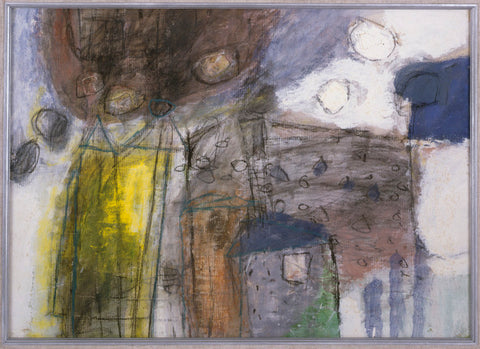Jaap Nanninga (Winschoten 1904 – The Hague 1962) was an abstract artist from The Hague. Jaap studied art at the Free Drawing Academy Pictura in Groningen and the Academy of Visual Arts in The Hague and the Rijksakademie in Amsterdam and was a student of Paul Citroen, Werkman and Jan Wiegers, among others. He was friends with Piet Ouburg and Willem Hussem.

To support herself, Nanninga had various jobs as an advertising painter and quick draftsman. Only later in life would he live as a 100% artist. His first marriage was dissolved and from 1936 he lived a wandering life with a horse and caravan through Germany and Poland, where he met his second wife Maria Lange. In the winter of 1943 to 1944 he left their home and settled in the painter's house and lived with, among others, Paul Citroen, Willem and Theo Bouthoorn, Gerard Lutz and Hans Kroesen. The artists exchanged a lot about modern French painting: cubism and fauvism.
He had his first solo exhibition shortly after the war in 'Kunstzaal Les Beaux Arts' in The Hague. He traveled to the Riviera, where he came into contact with the work of Marc Chagall, Georges Braque, Georges Rouault and Vincent van Gogh. He then spent several times in Paris, where he attended the Académie de la Grande Chaumière and was trained by Geer van Velde.
Nanninga loved color and was therefore fascinated by Karel Appel and the Amsterdam 'Experimentelen' (later Cobra). However, Nanninga worked with a matte paint that he composed himself; He thought Appel's red was too bright. He first prepared his canvases with a base layer of chalk, which makes everything look matt. Anton Rooskens and Appel visited Nanninga and Piet Ouborg from Amsterdam to see if they wanted to join Cobra, but that never happened.

During the war years, Nanninga was not yet ready for abstraction, as were most of the Hague artists around him; At the time, according to his teacher Lydia Duif, he thought abstract art was 'not honest art'. Around 1948-49, Nanninga came into contact with Willem Hussem and through him became interested in primitive art (often African), which strengthened his tendency towards abstraction.
Nanninga was a colorist who searched for a very individualistic and poetic visual language. Eastern mysticism and 'primitive cultures' gave him inspiration; many of his paintings bore titles that referred to these cultures. He called other works Compositions; which referred to the elements of color, line and shape. In addition to being a (glass) painter, Jaap was also a monumental artist, textile artist, manufacturer of mosaics and gouaches. Subjects were often (flower) still lifes, animal and figure representations, landscapes, abstractions and portraits.
At the initiative of Nanninga, a number of experimental painters from The Hague exhibited in café 'De Posthoorn' from 1949 onwards. Artists such as Jan Roëde, Willem Hussem, Hans van der Lek, Gerard Verdijk, Dirk Bus, Nol Kroes, George Lampe, Jan Cremer, Lotti van der Gaag, Theo Bitter, Karel Bleijenberg, Kees van Bohemen, Jos van den Berg and of course Jaap themselves, were allowed to exhibit there for free. The gallery closed its doors in 1962. Nanninga's work had become darker and more abstract in the 1950s. His abstract work has a strong formal language with a wonderfully subtle and soft appearance.
When Nanninga was very ill in 1957, director of the Stedelijk Museum Amsterdam, Willem Sandberg, discovered Nanninga and immediately decided to mount an exhibition of Nanninga's work at the Stedelijk, which was then repeated at the Gemeentemuseum Den Haag. He also started to break through internationally; In 1958 he participated in the Venice Biennale with Gerrit Benner and other Dutch artists with 19 of his paintings and also visited the exhibition himself. The following year he took part in the São Paulo Biennale together with Appel and Corneille. Nanninga died in early 1962 after a traffic accident, at the age of 57. Nanninga was a member of the League of New Images, of the Posthoorngroep in The Hague and of Pulchri Studio in The Hague.

